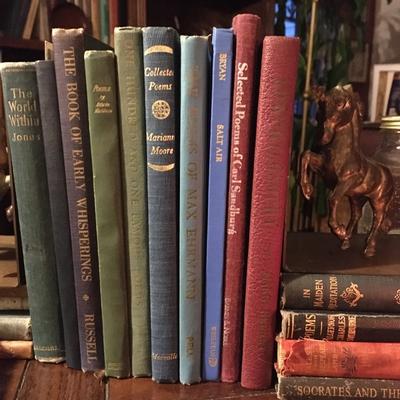Fake Books

I stifled a laugh
when my neighbor
declined my offer of
free books
for her empty shelves.
"No," she said, "I was
thinking of gettings those
fake books
you can buy that
look real."
Empty bookshelves still empty.
I'd thought my Literary Guild
classics in matching sober bindings
with gold titles
would seem decorative to her.
But real books unread
are a bigger sham than
fake books.
I have a room of full bookshelves, now,
and, laughing again at the neighbor,
I wonder:
Are my books merely for show and fill?
One candidate for being decorative
might be the set of
leather-bound Great Books.
But ... I read those occasionally.
Mostly unread is the 20-volume
vintage edition Washington Irving.
Even knowing how unlikely reading
them would be,
I wanted all of him because
"Knickerbocker's History of New York"
cheered me in a dark time.
The slim hardbacks in
richly-dyed cloth covers on
the table between the brass
Pegasus and Unicorn bookends
qualify as decorative.
But … the heavy endpapers
and flyleaves and three title
pages with tissue covering
the frontispieces ...
so nice to hold, to see how
the sewn pages stay intact.
Intact because unread?
A full bookshelf gives the
security of always having
something to read that
was picked just for me.
And insulates against winter drafts.
The big, thick art books,
coffee-table books, are
handsome on the shelves.
And useful in the need for
non-verbal stimulation
or to boost a toddler at
the dinner table.
The tiny volume of illustrated
quotes, open on an art stand
on the mantle, is a spot of color.
But … also an opportunity
in a spare moment
to ponder someone else's
careful words.
True, my grandkids
haven't read the pile of
colorful titles on the bottom shelf
by Scary, Sendak, Salton, Seuss,
Baum, Burnett, Mother Goose.
But … they will eventually.
One rule of decluttering is:
"Just because you have room
doesn't mean you need it."
So … am I filling up space with books?
Overfilling.
The last three novels from the
Little Free Library
are slid sideways on top of the
"to be read" row.
All those public library discards —
old wellness bestsellers —
Andrew Weil, Herbert Benson, Bill Moyers —
shining in their cellophane, still sporting
Dewey Decimal tags.
Not decorative.
Not read.
But … still valuable information there.
This gold-stamped, cloth-covered,
illustrated 1954 Muir,
in which I have perused every word
sits showily facing outward.
When I found it I happily gave away
the same essays
in a sloppy facsimile paperback.
This collection is curated.
Although it contains three copies of
"A Room With a View."
Couldn't give up the first edition
or the one I highlighted
just because it's also in a Forster anthology.
"Annotated Wind in the Willows"
hardly counts as a duplicate
of the 1913 edition.
Never mind that I own
"Annotated Alice," and another version
(newly illustrated) sits with the kids' books,
also the edition that includes
"Through the Looking Glass"
with the Tenniel drawings, and
a paperback in the glove compartment,
plus its inclusion in Complete Works.
I have a one-in, one-out rule
for books, borrowed from the
recommendations for
keeping clothes closets under control,
so this collection revolves,
renews, grows no larger.
Neither does it shrink.
Although this book sits here to show the one
who gifted it that I appreciate him,
others I've re-gifted.
The tattered, crayoned 80-year-old
"Scat, Scat" with my name inked in
proud awkward capitals,
shelved out of reach of the grandkids
so it won't fall completely apart
is staying here while I'm alive.
I seem defensive about my books.
Then I remember the visitor who
exclaimed, "Have you read all these?"
My answer: "Most."
This record of my path,
this accretion to my personality,
this ponderous accumulation,
dusty from disuse ...
Are my books sham?
I answer only to myself.
And I'm still asking.